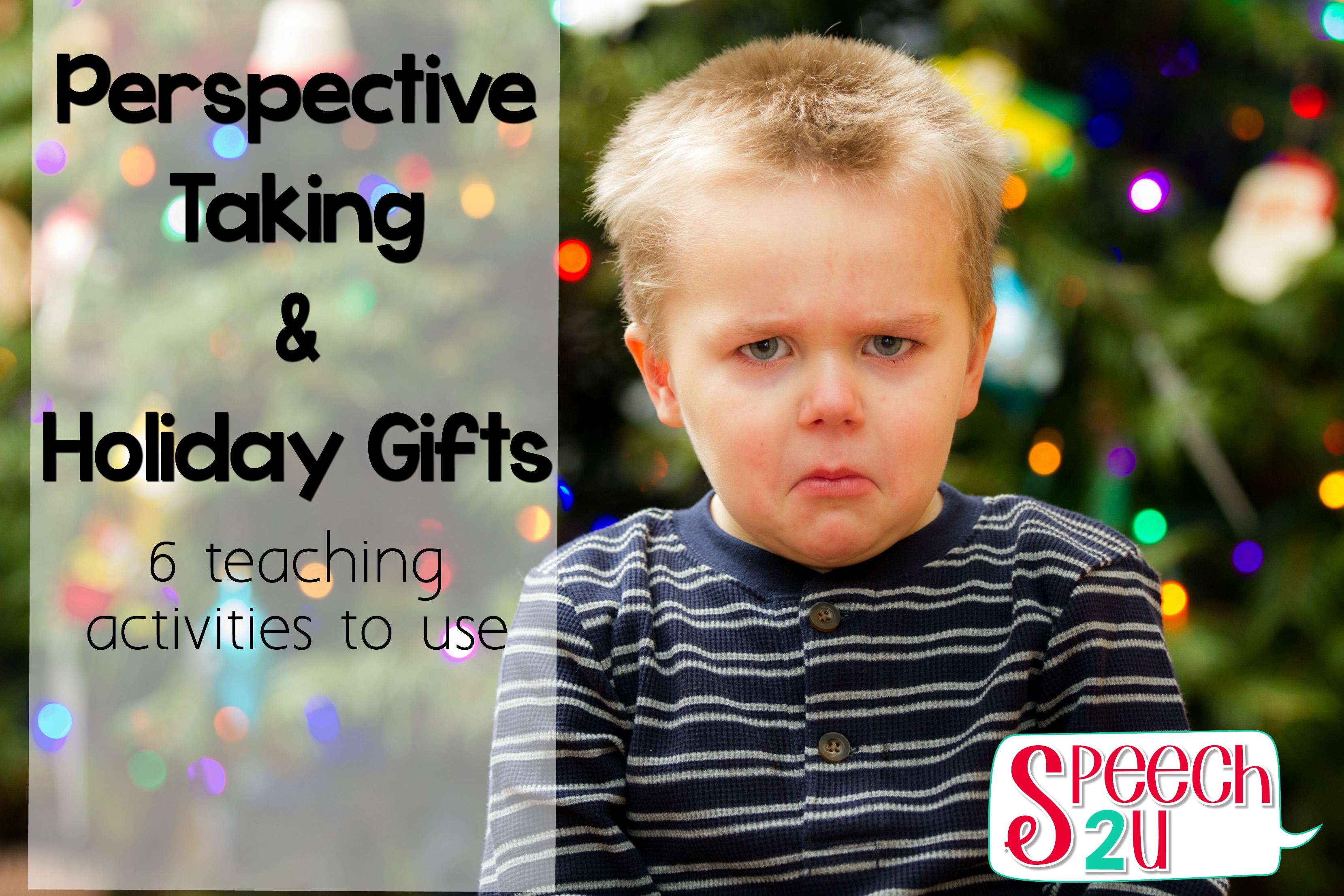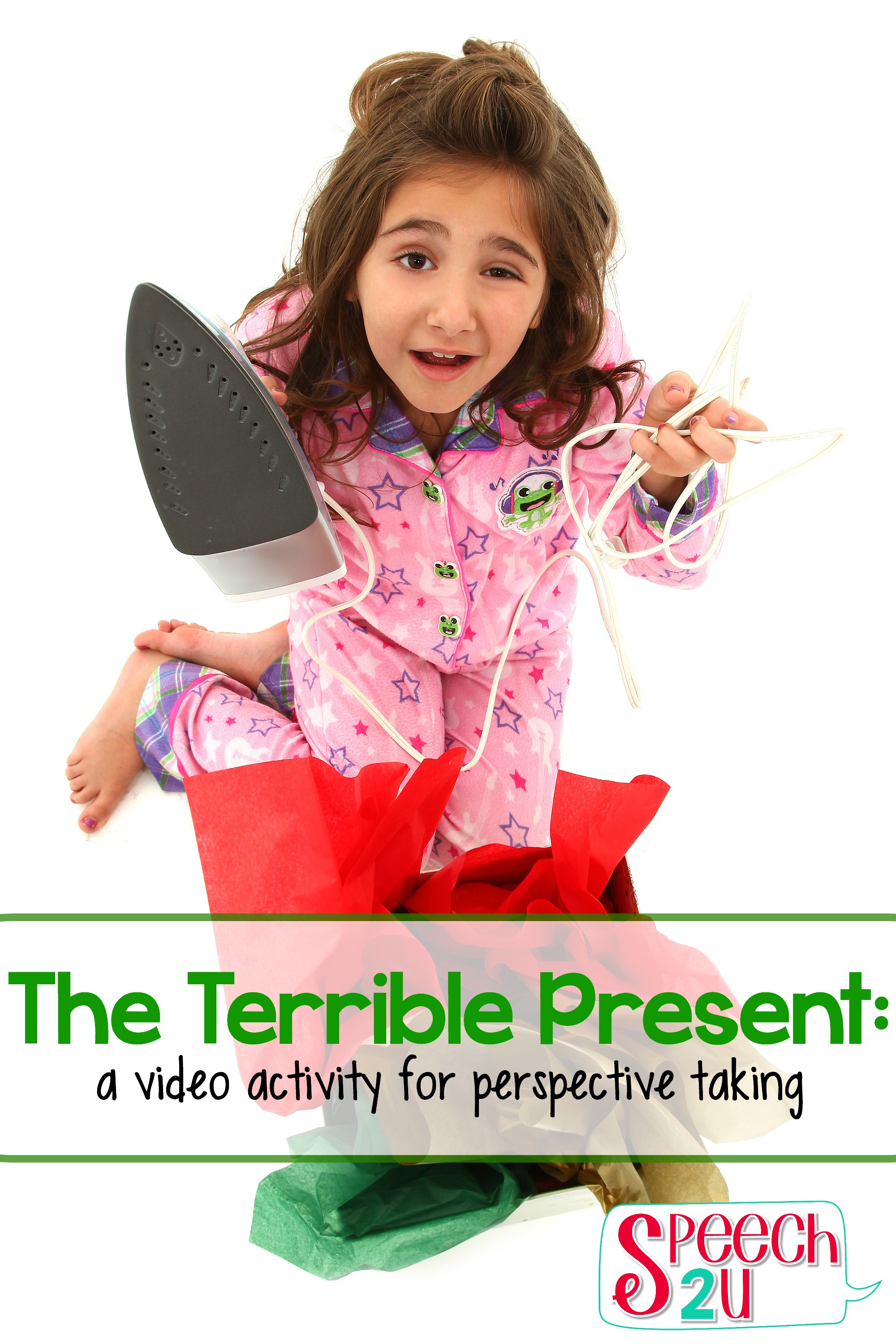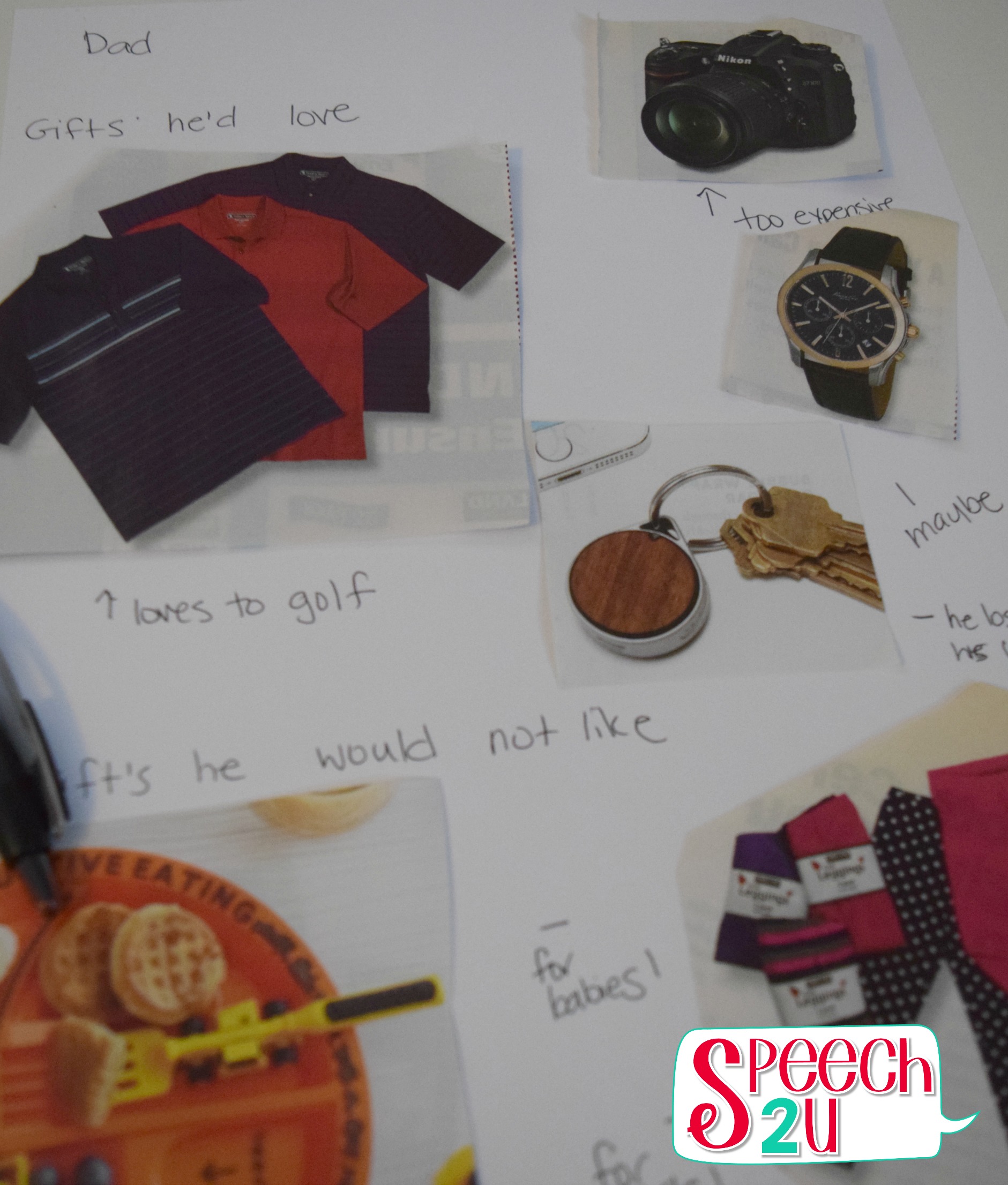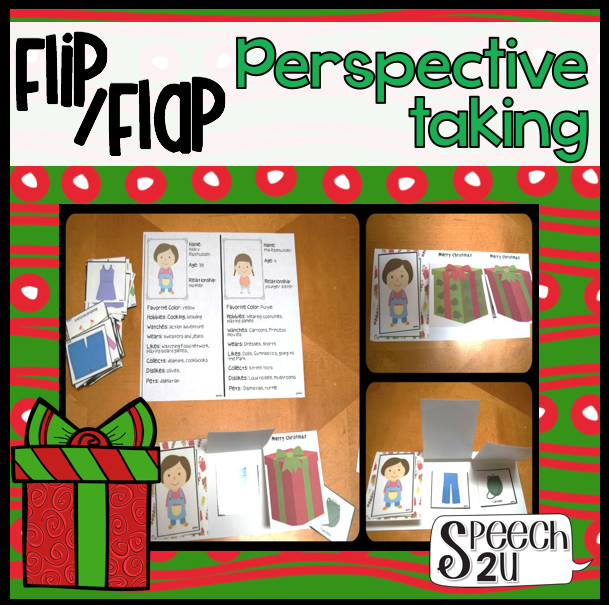Are your students able to think about other people’s perspectives when thinking about presents at the holidays?
This is a hard skill for a lot of neurotypical adults such as my husband. One year, he bought me a child sized Tinkerbell towel at Target. First of all, I am not a one of those fortunate child sized ladies. Why would he get me a gift that I can’t even wrap around myself? When he gave it to me, he was so excited because I LOVE Tinkerbell. Um….no.
The next year he bought me a Tinkerbell lip gloss watch. It’s not actually a watch-it’s just cleverly designed to look like a timepiece. You can open the lid and it conveniently stores grape lipgloss. This could be an appropriate gift for a genius Doogie Howser style SLP, but I’m a 44 year old in the trenches SLP veteran. It’s pretty hard to be taken seriously as a speech language pathologist when you are constantly stopping to hydrate your lips from your lipgloss watch (which doesn’t even tell time).

Perspective Taking and Choosing the Correct Gift
Choosing a gift requires you to think about the other person. It touches on social cognition, theory of mind and pragmatic language. It’s a great opportunity to use our “friend files” by remembering information about people. I use this activity with my clients who are also working on conversation skills and choosing appropriate conversational topics.
Questions to think about when getting a gift
- How old are they?
- Are they a boy or a girl?
- Do they have any hobbies?
- Have they mentioned that they need or want something?
- Who is in their family?
- Do they have any pets?
- What about favorite movies, t.v. shows or other special interests?
- Do you know what they already have?
- Is there anything they really DON’T like?
Perspective Taking Activity with Sunday Ads
Materials:
- Sunday Ad/Toy Ads
- Pictures of the Child’s friends, parents etc.
- Blank Paper for each gift recipient
Place a variety of ads on the table and have your student or client determine what store would be appropriate for the gift recipient. You can use the questions above to help guide their decisions. Have them explain their choices. For example, maybe they will look in the Kohls flier for their grandma because she always shops their on senior discount day. Have them read through the ad and cut out 3-5 pictures of items that they think the gift recipient would like.
Now you can discuss how to narrow down your options. Price might be one factor. You could extend this activity by creating a “budget” and having the student determine where to spend the money or discussing concepts such as greater than/less than.
I don’t expect that my clients (or clearly, my husband) will be able to think of the “perfect” gift so as long as they are in the ball park of an appropriate gift, I would give them credit for it.
Gift Giving: Video Perspective Taking Activity
A few years ago, Jimmy Kimmel had a segment on his show called, “I gave my kids a terrible present.” In it, parents across America wrapped up cleaning products and old bananas and gave them to their children as presents. My clients love this video-they get to see other children exhibiting unexpected behavior and can give the “advice” on how these children should handle themselves. If you decide to use the video, make sure to preview it first. There are two versions. In the first version, the last child uses profanity. It is bleeped out but you can tell what word he said. In the second version, there is a child who may be using the middle finger. It’s fast so I couldn’t tell for sure.

Here are a few targets I use in therapy with this video:
- Identifying expected and unexpected behaviors (from both the parents and the children).
- Matching the size of the reaction to the size of the problem
- Teaching theory of mind and strengthening perspective taking skills. For example:
- What do you think that the girl wanted for Christmas? Packer’s Jersey
- What did she get? Bears jersey
- How did she feel? Disappointed and angry at her parents.
- Why? Because she knows that they know she likes the Packers so WHY would they get her a different jersey.
- How would they feel if they thought they were getting a specific present and their parents got them something different?
- How do our parents know what we want?
- Strategies for calming when upset
- self talk (it’s okay, I’ll get better presents)
- four square breathing, deep breathes
- think about something else
- Strategies for determining sarcasm or pranks.
- Does my parent know that I don’t like Barbies?
- Does it make sense that they would get me a barbie?
- Could they be teasing me?
My husband tried this with our son last year when he was three. He didn’t have expectations of what a “Christmas gift” should be yet, so he was really excited to get a can of Spray starch. (That this was what my husband picked would be the subject of a whole different blog called, 101 dangerous gifts my husband tried to give to our kids.) He also gave him this present. Notice how my son cleverly uses the non compliment thank you strategy I talk about later.
Perspective Taking: Accepting a good or pretty terrible present
Struggling with how to accept an unwanted Christmas gift is part of normal development, but for children with Autism Spectrum Disorders and other pragmatic language impairments, more direct teaching is required. Here are some ideas I’ve used in therapy:
Social Stories:
Social Stories are a great opportunity to give a child more information about what will happen during gift opening time. An example would be something like: “On Christmas Morning we will eat breakfast and then it will be time to open gifts. Everyone gets to take a turn opening a gift. On my turn, I will open my gift and see what it is. Most of the time, my gifts are things that I like. Sometimes they are not. When I get a gift I don’t like, I can try to smile and say, “Thank you” to the person who gave it to me. This makes them feel happy.”
Role Play:
Years ago, I bought a fabric wrapped box with a bow on it. We practice putting gifts in it and using a script to “thank” each other. I try to have 5 things I think the client would like and 1-2 silly or unexpected gifts. In a group, you could have your students choose 3-4 items that they they their peer would like and 1-2 that they probably wouldn’t like. Using your toy catalog, you can have them cut out the preferred or non-preferred items.
Teach the Non-compliment Thank you:
Some of my clients have difficulty with flexibility and struggle to get past the idea that saying “I like it” is lying. We talk about why we would “fake” interest in a present and how people feel when we give them a present. We have to use the “social fake” that Michelle Garcia Winner has coined. I teach these clients to use a noncompliant thank you approach. I use this all the time with my husband. Let’s pretend I got a t-rex for Christmas (and pretend that I didn’t actually love that!)

First name the item. I would open the box and say, “Wow! A T-Rex.” You finish by making an observation regarding the present. “I can’t believe it’s arms are so tiny.”
I hope these ideas inspire you in your speech room. Looking for something to make this even easier? You may want to check out my: Flip Flap: Perspective Taking and Holiday Gifts activity on Teacher’s Pay Teachers.
Question: What activities have you used to teach perspective taking?




Oh my goodness! That video is priceless!
This post is something that I guess I’ve never given much thought about with my own kids. We’ve taught them to be gracious when someone gives them something…anything, but looking at our students with social issues adds another dimension to it.
This is an excellent post!